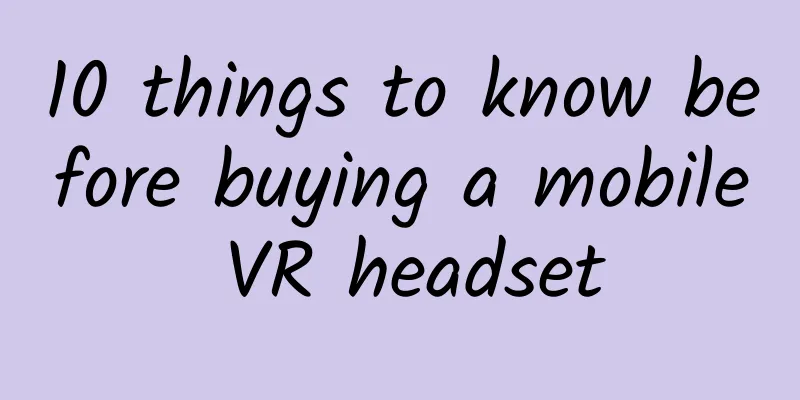10 things to know before buying a mobile VR headset

|
1. Field of view Some of the most popular domestic head-mounted displays on the market, as well as some early expensive head-mounted displays, have a relatively narrow field of view, either because the lens is too far from the phone screen or because it is designed specifically for small, low-resolution phones. Especially in developing countries, where the main purpose of head-mounted displays is personal virtual cinemas, the field of view of these head-mounted displays is relatively small. So how big should I look for? Generally speaking, as long as it is more than 90 degrees, it is a good choice. For example, the field of view of Samsung Gear VR is 96 degrees. My current favorites are LeNest and FiiT, both of which are 102 degrees. Here’s what a 90-degree field of view looks like on a Galaxy S6: The image seen by the small phone is smaller, but the field of view is wider, which makes people feel like they are wearing a mask to see things. Some of the edges are because the image of the phone itself is not large, and some of them are also because the head display is not large. In order to squeeze all the video into the field of view, the field of view is narrower. The image seen by the Galaxy S6 with a 102-degree field of view headset is as follows: The image fills the entire phone, with the only visible edge being the bezel of the headset. 2. Weight Generally, users always want the headset to be as light as possible, but also have a certain quality to prevent it from breaking. For example, although a headset made of tissue paper is very light, it is impossible to use it normally. A headset made of cardboard is also very light, but it will not last long. As a free sample, it is good to let everyone experience virtual reality, but it is definitely not the kind that you want to pay for. Then we come to the more expensive open-type headsets, which look like sunglasses. These glasses are also very light and can be folded into a pocket, so they are very convenient to carry around when you want to share VR applications with others. My favorite is the GoogleTech C1-Glass, the black pair on the far left. To the right of it is the Cobra VR glasses developed by Homido Mini, followed by AntVR and the pink Baofeng Small Mojing. Fully enclosed headsets like the Samsung Gear VR are heavier and have more parts. Open-type headsets generally weigh between 30g and 160g and are usually fixed by a headband. The Gear VR in the picture below weighs 340g before connecting the phone. 3. Headband If you plan to wear the headset for a long time, you will need a head strap. Without a head strap, you will need to use your hands to support the headset on your face. Generally, open-type headsets do not come with head straps, but cardboard-type headsets have two options. Fully enclosed headsets generally come with head straps, except for the Mattel View-Master. This type of headset was originally designed for children, and the designer's original consideration was to prevent children from spending too much time on VR applications. 4. Device User Experience If you wear glasses, or if you have friends or relatives who need to share a headset with you, you need to consider a headset that is wide enough. For example, the Mattel View-Master is not wide enough, and neither is the Shinecon VR. Samsung Gear VR is OK, and so are LeNest and Baofeng Mojing 3. 5. Adjustable lens Generally speaking, the lenses in a VR headset are adjusted in two ways. The first is to adjust the distance between the lenses, or the pupil distance. If your eyes are farther apart, you'll need a headset with farther lenses; if it's for a child, you'll need a headset with closer lenses. The other way is to adjust the distance between the lens and the smartphone screen. For example, the LeNest mentioned above is an example where the lenses on both sides can be adjusted separately. This is very helpful for people whose eyes focus at different distances, like me. 6. Compatible with augmented reality Currently, many devices are not compatible with augmented reality applications. Mattel View-Master can do it, but it may just be a sales strategy. The Wizard Academy produced by Realiteer is different. For example, it can use the front camera of the mobile phone to track the magic wand held in the user's hand. Other augmented reality applications include tracking whether the user tilts his head forward or backward, which is a function that current mobile phone sensors do not have. It can also prevent users from bumping into walls or furniture, or placing virtual monsters in their homes or offices. In addition, the shell of Mattel View-Master is translucent. When watching the "experience scrolls" distributed by the company through the screen, you can see different objects in front of you, such as the space shuttle, appearing above the user. Other head displays either have no shell or are hollowed out in the shell to facilitate the placement of cameras for shooting. 7. Compatible with audio and sockets Sound is important for the immersiveness of the VR experience, especially Google Cardboard, which supports special sound effects. If the user covers all the edges of the phone when using the headset, the user cannot use headphones. At the same time, there is no access to the power plug, so when watching a long movie, you have to worry about whether there is enough power. The head display shell in the picture below is not completely closed like the rest of the head display, but has openings on both sides of the top and bottom. Such openings can also help cool the head display and prevent the lens from fogging. 8. Controller Google Cardboard V1 is the first headset released by Google. It has a magnetic button on the side. With a light press, the headset will fall off immediately. Of course, this headset does not work with all mobile phones. Another headset has a capacitive touch screen, which allows users to control the phone screen without taking off the headset. In addition, open headsets naturally do not have these problems: just touch the screen. However, there are also many fully enclosed headsets that do not have similar buttons. These companies are also working with many Google Cardboard applications, because designers are also aware of this defect and hope that the current applications can be mainly interacted with through pupil focusing. Other headset manufacturers have tried to solve this problem by bundling external remote controls. In general, to ensure user experience, either choose a headset with built-in buttons, one that can directly operate the phone, or one with an external remote control. 9. Price Current mobile VR headsets vary in price: Open-frame, foldable headsets range from $5 (VR Fold on AliExpress) to $22 (GoogleTech), cardboard headsets range from $1 to $30, and plastic headsets can go up to over $100. Some big-brand headsets that have been on the market for a while are priced high, such as Merge VR at $100, Fibrum at $130, Homido at $80, and Zeiss VR One at $120. I personally think these products are not good value for money unless users really like the look of a certain model and are willing to make sacrifices for it. VR headsets are currently priced reasonably between $20 and $50. My favorites include the Mattel View-Master, Baofeng Mojing 3, and LeNest. The companies behind these products seem to have sold enough units to continue investing in R&D, and as the volume increases, the price will come down. 10. Comfort of use Comfort is the most important factor for me when buying a headset. Would you like a headset that requires you to take off your phone case every time you use it? I chose headsets that can be plugged in directly. Most open-body lightweight headsets don't have this problem: the phone just sits on the support. LeNest's solution is also simple: the shell opens and you can put the phone directly in, and then close the shell again. But some headsets are very complicated. For example, Freefly VR requires users to read the instructions before each use because they may not remember the instructions next time. If the method of embedding the headset into the phone is too complicated, switching apps, playing new videos, and even changing settings will be troublesome because these all require the use of the phone's touch screen, so buyers need to consider carefully. |
>>: 【51CTO Network+】How to make a product that attracts users to call
Recommend
High repurchase fan community operation strategy
Among the three major categories of communities, ...
It's rude to be hotter! Is it really normal to be so hot this summer?
I don't know if you have noticed that every y...
What are those plants that look like garlic? Recognize them, beware of poison!
Produced by: Science Popularization China Author:...
Glutinous or sweet? The "corn dispute" escalates again!
Popular Science Times reporter Wu Qiong Recently,...
What! Tangshan, a city that mines coal and makes steel, is actually the best in the country in terms of pufferfish farming?!
Pufferfish is a fantastic ingredient that has a p...
Can you fly directly to the moon by putting on the Iron Man armor?
Follow Captain Da Shanzha Wan Set sail for the st...
Subsidy policy for rural veterans over 60 years old in 2022: How much per month?
Soldiers shoulder the heavy responsibility of def...
Has Zhengzhou been unsealed in 2022? Which specific areas have been unblocked? Attached is the latest official notification on the time of unblocking
The main urban area of Zhengzhou began to imple...
Xixi Word 4300, suitable for postgraduate entrance examination level 4 and 6
Xixi Word 4300, suitable for postgraduate entranc...
Which copywriter is the best at leveraging the Labor Day campaign?
It’s not Labor Day yet. The chat mode of " w...
Alibaba was reported to have acquired Sina: "The godfather is about to become the biological father"
[[155008]] Sina Chinese e-commerce giant Alibaba ...
Why do we put small stones in sugar-roasted chestnuts? Can bright chestnuts cause cancer? The truth is…
Expert of this article: Pa Lize, chief physician ...
Hyundai's next-generation fuel cell SUV combines the advantages of range and style
Hyundai Motor has unveiled its next-generation fu...
High-quality case studies on information flow delivery in the automotive industry
It’s the end of the year and it’s the crazy car b...
Practical guide to attracting new customers with Tencent advertising!
1. Advantages of Tencent Trading Site 1. Expandin...




![Gentle White is Not White · Douyin 0-cost project: single-day income of 500, no work release, no account maintenance [video course]](/upload/images/67cc2821117aa.webp)




